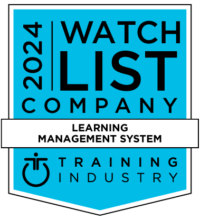By delivering consistent training to everyone and measuring individual and collective impact, eLearning tools can help change attitudes and behaviors, both essential ingredients to turning DEI strategies and policies into a reality.
How LMS Technology Can Play A Role In DEI Strategies
Plenty of evidence proves the benefits of a diverse and inclusive culture [1]. From enhanced innovation and increased profitability to talent recruitment, engagement and retention, DEI (diversity, equity, and inclusion) initiatives have become a top priority in every organization striving for success.
Creating a DEI strategy is only the first step; putting subsequent DEI policies into action is where the real magic happens. Unfortunately, many organizations are struggling to turn their DEI goals into real, measurable results. It’s a tough job that often requires a substantial cultural shift. It’s not just about promoting underrepresented groups; employees must feel comfortable and confident in the environment and able to bring their authentic selves to work.
Streaming and LMS platforms can help drive this kind of cultural shift by delivering on-demand educational content and insightful learning analytics to managers [2]. By delivering consistent training to everyone and measuring individual and collective impact, these eLearning tools can help change attitudes and behaviors, both essential ingredients to turning DEI strategies and policies into a reality. Here are 6 tips to help your journey:
1. Assess And Monitor
Employees want to work for organizations that make diversity [3] and professional growth [4] top priorities. Having the right tools to track and measure your Learning and Development initiatives is essential to monitor employee growth. LMS analytics can help you understand how employees, teams, departments and managers are participating in, and engaging with, educational efforts.
Once you can see who’s engaging in training and where gaps may lie, you can identify strategies to engage low-participating populations. From the baseline measurement, you can monitor progress and further refine training content, delivery, engagement, and outcome.
2. Support Career Pathing
Welcoming more underrepresented individuals into management is a top priority for many organizations. Proper career pathing is essential for putting staff on the right course, as well as building your leadership funnel.
Career pathing is the process used to structure the development of the employee’s knowledge, skills, and experience required to progress in their career [5]. In general, eLearning platforms make it easier for employees to stay on the right path given 24/7 content availability, cross-device functionality, and course and status tracking. Video-on-demand streaming may deliver the content and track user basics, but to really understand how an individual is progressing, an LMS platform does a better job of tracking engagement with in-depth, customizable metrics.
3. Provide Equal Access To Information
LMS platforms offer options for automatic tracking of certifications and knowledge progression, content testing to measure comprehension and scenario application, plus notifications to alert employees, managers, and administrators of training needs and opportunities. These features help your organization make sure no one, particularly marginalized individuals, falls through the cracks.
4. Make Training Culturally Inclusive
If employees don’t see themselves represented or their unique needs addressed within training materials, they’re less likely to participate. This cultural bias can make employees feel like they don’t belong and less inclined to stay engaged in their work.
eLearning offers a great opportunity to expand inclusiveness, as it frequently crosses borders, cultures, economies, and neighborhoods. When you design course materials, remember to include a diverse representation in people, language, and delivery methods to accommodate different learning styles, which also vary culturally to some degree.
5. Deploy Unconscious Bias Training
Training employees on DEI policies isn’t enough to drive systemic change. Most individuals do not recognize their unconscious biases and behaviors, and they are often blindsided by the culture with which they are most familiar [6]. Blended, in-person or VILT (Virtual Instructor-Led Training), and scenario-based eLearning can help uncover issues and foster conversations around bias topics. Consider recruiting marginalized employees to share their perspectives and experiences with bias in your organization. When employees see how it affects their coworkers and colleagues, it makes the problem real and relevant, rather than hypothetical.
6. Include Diverse Trainer Voices
Hearing from peers is a terrific way to keep employees engaged in training, and the content often feels more relevant [7]. eLearning platforms provide enhanced opportunities for trainers and employees, regardless of geography, to develop and deliver content in their area of expertise.
In addition to deploying appropriate content, using the right training technology can play a pivotal role in fostering DEI in your organization. At the core, LMS platforms are designed to deliver, engage, track and manage change to create a culture of continuous learning, growth, and success. Using your LMS to support DEI initiatives can help create equal opportunities for growth across the company, position your organization as a committed DEI advocate, and help you fully leverage the benefits of an inclusive employee population.
Initially published at eLearningIndustry.com






